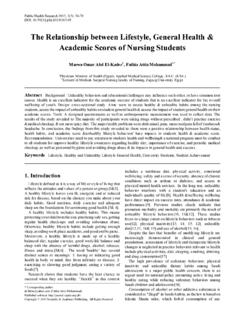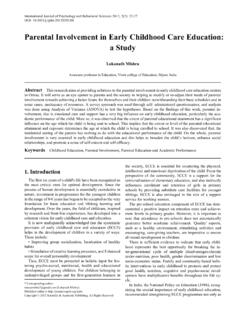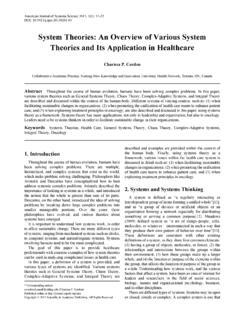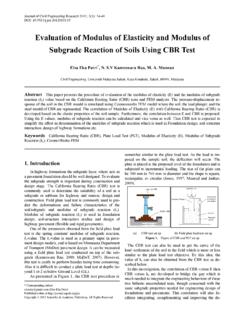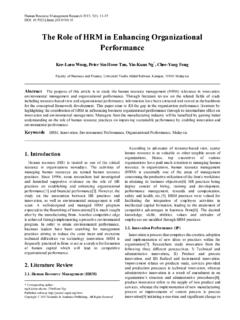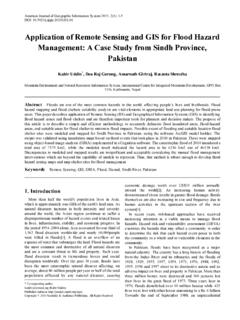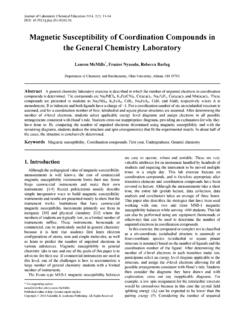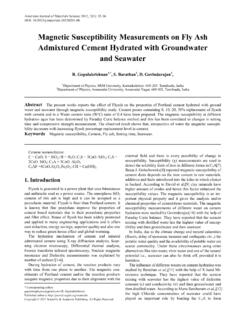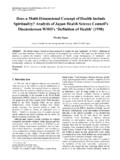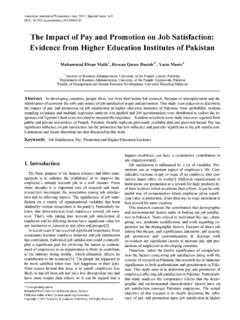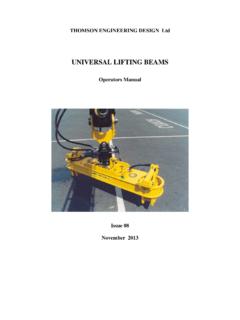Transcription of CFD Modelling of a Horizontal Three-Phase …
1 American Journal of Fluid Dy namics 2013, 3(4): 101-118 DOI: CFD Modelling of a Horizontal Three-Phase separator : a population balance approach N. Kharoua1, L. Khe zzar1,*, H. Saadawi2 1M echanical En gineer in g Dep artment, Petroleum Institute, Abu Dhabi, United Arab Emirates 2 Abu Dhabi Comp any for Onshore Oil Op eration (ADCO), Abu Dhabi, United Arab Emirates Abstract The performance and internal mult iphase flow behavior in a Three-Phase separator was investigated. The separator considered represents an existing surface facility belonging to Abu Dhabi Co mpany for Onshore Oil Operations ADCO. A first approach , using the Eulerian-Eu lerian mult iphase model imp le mented in the code ANSYS FLUENT , assumed mono-dispersed oil and water secondary phases exc luding the coalescence and breakup phenomena.
2 Interesting results were obtained but noticeable discrepancies were caused by the simp lifying assumption. Therefore, it was decided to use the population balance Model PBM to account for the size distribution, coalescence, and breakup of the secondary phases which were the key limitat ions of the Eule rian-Eulerian mode l. The separator configuration, with upgraded internals, was represented with the ma ximu m of geometrica l details, contrary to the simp lifying approach adopted in most of the previous numerical studies, to minimize the sources of discrepancies. In the absence of field information about the droplet size distribution at the inlet of the separator , three different Rosin-Ra mmle r distributions, referred to as fine, mediu m, and coarse distributions were assumed based on the design values reported in the oil industry.
3 The simulat ion results are compared with the scares laboratory, field tests, and/or semi-e mpirical data e xisting in the literature. The coarser size distributions, at the inlet, enhanced the separator performance. It was found that the inlet device, called Schoepentoeter, generates a quasi-mono-dispersed distribution under the effect of coalescence which persists throughout the whole volume of the separator . The mean residence time obtained fro m the simulat ions agreed we ll with some of the e xisting approaches in the literature. Finer d istributions generate higher mean residence times. The classical sizing approach , based on representative values of droplet diameter and settling velocity re mains limited although useful for design guidelines. In contrast, CFD presents the advantage of calculating the flow variab les locally wh ich yie lds a mo re co mplete and detailed picture of the entire flo w field.
4 This is very useful for understanding the impact of the internal multiphase flow behaviour on the overall performance of the separator . Keywords Three-Phase separator , Droplet Size Distribution, population Ba lance Model, Coalescence, Breakup 1. Introduction Diffe rent types of surface facilities are used for phase separation in the oil industry[1-2]. Gravity-based facilities include Horizontal Three-Phase separators consisting of large c y lind ric a l vess e ls d es ig ne d t o p rov ide a su ffic ie nt res id ence t ime fo r g ra v ity-base d sepa ra t ion o f liqu id droplets. The gravity settling approach requires very long cylinders wh ich is not practical and inconsistent with the space restrictions in the oil fie lds especially offshore. Hence, Three-Phase separators are equipped with diffe rent types of internals to enhance droplet coalescence and optimize their length.
5 A mo mentum breake r device is imple mented at the inlet of the separator to reduce the high inlet velocity of the * Corresponding author: (L. Khezzar) Published online at Copyright 2013 Scientific & Academic Publishing. All Rights Reserved mixtu re. At this stage, the liquid phase is separated fro m the gas forming two distinct layers. Further downstream, perforated plates are used to stabilize the liquid mixtu re forming two distinct layers of water and oil. These two layers are separated by a weir placed at the end o f the separator between two outlets for each liqu id phase. The gas phase leaves from its own outlet at the top of the separator . The design approach of Three-Phase separators is based on semi-e mp irical formula obtained fro m Stokes la w[1]. The resulting equation, for the settling velocity based on a chosen cut-off droplet d ia meter, contains a correction factor which depends on the separator configuration[3].
6 Although useful guidelines are provided by this approach , crucial informat ion, affecting the separator performance, is not considered. At the inlet of the separator , different flow regimes do occur and a realistic droplet size distribution needs to be considered and tracked throughout the separator compart ments to take into account the effects of coalescence and breakup. The interna l mu ltiphase flow is 102 N. Kharoua et al.: CFD M odellin g of a Horizontal Three-Phase Sep arator: A Pop ulation balance Ap p roach assumed to be stable with three distinct gas/oil/water layers separated by sharp interfaces. This is not always the case since previous studies showed that several co mple x phenomena could take place under different conditions such as liquid re-entrain ment[4], rec ircu lation zones within the liquid layers[5], and a dispersion emulsion band between the oil and water layers[6] or foa ming[7].
7 The abovementioned limitations, of the se mi-empirical approach , invoke the need of more funda mental and thorough methods based on first princ iples fo r a mo re consistent design of separators and assessment of their performance. Expe riments represent a viable alternative or comple ment as they can replicate rea l cases under realistic conditions and provide more details using different measure ment and visualization techniques. However, e xperimental techniques are costly and very difficult to apply for sizes approaching real scale and using real fluids. Consequently, only few studies have dealt with such large scales for limited purposes as done by Simmons et a l.[8] for the estimation of the Residence T ime Distribution (RT D) based on e xperiments with t racers.
8 On the other hand, studies using laboratory-scale separators do exist in the literature although for specific purposes as well. Wald ie and White[9] studied the damping effect of the baffles using electrica l conductance level probes. Simmons et a l.[10] devoted their study to the RTD measure ment using spectrophotometer placed downstream of the liquid outlets. Jaworsky and Daykowski[11] used a transparent separator to test their distributed capacitance sensors. The e xperimental investigations re ma in crude with a focus on global para meters. Details of the internal flow fie ld and phase compositions still re ma in e lusive with present day techniques. Co mputational fluid dyna mics (CFD) represents an alternative tool gain ing more confidence within the industrial co mmunity due to the development of mo re robust numerica l and physical models and the huge development in terms of computing resources.
9 It is more universal than the semi-e mp irical mode ls and more fle xib le than the experimental techniques. Among previous studies we can mention those developing appropriate models to take into account the droplet size distribution in conjunction with coalescence and breakup phenomena[12-14] or to understand the effects of certain para meters on the separator performance and internal flow[15-16]. Industrial investigations which focused on parametric CFD studies for debottlenecking purposes include[17-19]. Due to the comple xity of the mu ltiphase flow in Horizontal gravity separators, simp lifying assumptions were always necessary which limited the accuracy of the CFD approach to an acceptable scale fro m an industrial po int of view and provided useful guidelines for design and troubleshooting of operational proble m.
10 The mu ltiphase flow was usually assumed to include only two phases while Three-Phase simulat ions were scarce. The Reynolds averaged Navier-Stokes-based (RANS) k- turbulence model, the work horse in industrial CFD, was combined with mu ltiphase models due to its robustness, simplicity and reasonable co mputational cost[20]. Ba ffles were modelled as porous media. Last but not least, mono-dispersed secondary phases were frequently imposed excluding any possibility fo r droplet size variation e ither by coalescence or breakup especially within the Lagrangian fra me work. Therefore, only fe w contributions dealt with the secondary phases as poly-dispersed. Hallanger et al.[21] developed a CFD model based on the two-fluid model approach to simulate the Three-Phase flow in a Horizontal gravity separator .
